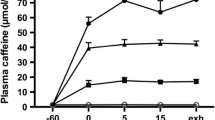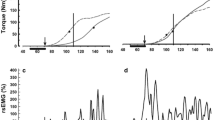Abstract
The Relaxometer is a computer-controlled system developed for reliable clinical experimental measurements on neuromuscular block. This system is based on an adapted personal computer (Atari 1040 ST) with a monochrome monitor (Atari SM 124), and a microcomputer-driven slave unit (stimulator). There are several stimulation patterns available: single twitch at 0.1 and 1 Hz, single train-of-four, continuous train-of-four every 12 seconds, and tetanic stimulation at 50 Hz for 5 seconds followed by posttetanic count. The system is equipped with a temperature module for continuous monitoring of the skin/muscle temperature and a rechargeable battery to allow uninterrupted measurements if the apparatus is disconnected from the line power. All acquired data, computer-calculated parameters (onset time, duration time, recovery index, train-of-four ratio, tetanic fade, and posttetanic count), and the mechanomyogram are presented on screen continuously, are stored on floppy disk, and can be printed in a well-organized format.
Similar content being viewed by others
References
Katz RL. A nerve stimulator for the continuous monitoring of muscle relaxant action. Anesthesiology 1965;26:832–833
Churchill-Davidson HC. A portable peripheral nerve stimulator. Anesthesiology 1965;26:224–226
Zeh DW, Katz RL. A new nerve stimulator for monitoring neuromuscular blockade and performing nerve blocks. Anesth Analg 1978;57:13–17
Viby-Mogensen J, Hansen PH, Jorgensen BC, Ørding H, Kann T, Fries B. A new nerve stimulator (Myotest). Br J Anaesth 1980;52:547–549
Epstein RA, Wyte SR, Jackson SH, Sitter S. The electro-mechanical response to stimulation by the Block-Aid Monitor. Anesthesiology 1969;30:43–47
Epstein RM, Epstein RA, Lee ASJ. A recording system for continuous evoked electromyography. Anesthesiology 1973;38:287–289
Lee C, Katz RL, Lee ASJ, Glaser B. A new instrument for continuous recording of the evoked compound electromyogram in the clinical setting. Anesth Analg 1977;56:260–270
Katz RL. Comparison of electrical and mechanical recording of spontaneous and evoked muscle activity. The clinical value of continuous recording as an aid to the rational use of muscle relaxants during anesthesia. Anesthesiology 1965;26:204–211
Walts LF, Lebowitz M, Dillon JB. A means of recording force of thumb adduction. Anesthesiology 1968;29:1054–1055
Ali HH. A new device for monitoring force of thumb adduction. Br J Anaesth 1970;42:83–85
Baraka A. Monitoring of neuromuscular transmission in anesthetized man by a bulb-transducer assembly. Anesth Analg 1973;52:36–38
Walts LF. The “Boomerang”—a method of recording adductor pollicis tension. Can Anaesth Soc J 1973;20:706–708
Carter JA, Arnold R, Yate PM, Flynn PJ. Assessment of the Datex relaxograph during anaesthesia and atracurium-induced neuromuscular blockade. Br J Anaesth 1986;58:1447–1452
Ali HH, Kitz RJ. Evaluation of recovery from nondepolarizing neuromuscular block, using a digital neuromuscular transmission analyzer: preliminary report. Anesth Analg 1973;52:740–744
Jensen E, Viby-Mogensen J, Bang U. The accelograph: a new neuromuscular transmission monitor. Acta Anaesthesiol Scand 1988;32:49–52
Ueda N, Mutek T, Poulsen A, Espensen JL. Clinical assessment of a new neuromuscular transmission monitor system (accelograph). A comparison with the conventional method. J Anesth 1989;3:90–93
Perry IR, Worsley R, Sugai N, Payne JP. The use of a digital computer for the on-line real-time assessment of neuromuscular blockade in anaesthetized man. Br J Anaesth 1975;47:1097–1100
Halar EM, DeLisa JA, Brozovich FV. Nerve conduction velocity: relationship of skin, subcutaneous and intramuscular temperatures. Arch Phys Med Rehabil 1980;61:199–203
Hubbart JI, Jones SF, Landau EN. The effect of temperature changes upon transmitter release, facilitation and post-tetanic potentiation. J Physiol 1971;216:591–609
Thornton RJ, Blakeney C, Feldman SA. The effect of hypothermia on neuromuscular conduction. Br J Anaesth 1976;48:264
Heier T, Caldwell JE, Sessler DI, Kitts JB, Miller RD. The relationship between adductor pollicis twitch tension and core, skin and muscle temperature during nitrous oxide-isotiurane anesthesia in humans. Anesthesiology 1989;71:381–384
Wiles CM, Edwards RHT. The effect of temperature, ischaemia and contractile activity on the relaxation rate of human muscle. Clin Physiol 1982;2:485–497
Eriksson L, Lennmarken C, Jensen E, Viby-Mogensen J. Twitch tension and train-of-four ratio during prolonged neuromuscular monitoring at different peripheral temperatures. Acta Anaesthesiol Scand 1991;35:247–252
Beaufort TM, Wierda JMKH. Kruyswijk JE, Agoston S. 2,4-Diaminopyridine: clinical evaluation of a recently synthesized 4-aminopyridine derivative for reversal of competitive neuromuscular blockade. Eur J Anaesthesiol 1990;7:453–457
Wierda JMKH, Kleef UW, Lambalk LM, Kloppenburg WD, Agoston S. The pharmacodynamics and pharmacokinetics of Org 9426, a new non-depolarizing neuromuscular blocking agent, in patients anaesthetized with nitrous oxide, halothane and fentanyl. Can J Anaesth 1991;38:430–435
Huizinga ACT, Vandenbrom RHG, Wierda JMKH, Hommes FDM, Hennis PJ. Intubating conditions and onset of neuromuscular block of rocuronium (Org 9426); a comparison with suxamethonium. Acta Anaesthesiol Scand 1992;36:463–468
Author information
Authors and Affiliations
Additional information
Atari ST 1040 and Atari SM 124 are trademarks of the Atari Corporation, Sunnyvale, CA.
Rights and permissions
About this article
Cite this article
Rowaan, C.J., Vandenbrom, R.H.G. & Wierda, J.M.K.H. The Relaxometer: A complete and comprehensive computer-controlled neuromuscular transmission measurement system developed for clinical research on muscle relaxants. J Clin Monitor Comput 9, 38–44 (1993). https://doi.org/10.1007/BF01627635
Received:
Revised:
Accepted:
Issue Date:
DOI: https://doi.org/10.1007/BF01627635




